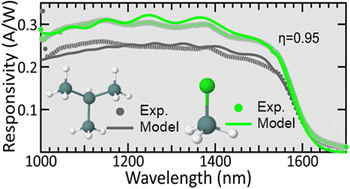Ultra-low temperature synthesis of Ge-based optical materials and devices on Si using GeH3Cl†
Abstract
We describe an alternative strategy to the fabrication of Ge–Sn based materials on Si by using chlorogermane (GeH3Cl) instead of the specialty Ge hydrides (Ge2H6, Ge3H8, Ge4H10) currently employed as ultra-low temperature sources of Ge. This simpler and potentially more practical chlorinated derivative is obtained in high yields and in research-grade purity by direct reactions of commercial GeH4 and SnCl4 and exhibits favorable physical and chemical properties that make it an effective source of Ge for a wide range of chemical vapor deposition (CVD) processing conditions. As a proof-of concept, we have employed GeH3Cl to demonstrate deposition of pure Ge and GeSn hetero-structures on large-area Si wafers, at conditions compatible with current specialty methods for next generation technologies but with higher deposition efficiency, ensuring an optimal use of the Ge feedstock. In the case of pure Ge, GeH3Cl has enabled growth of thick and uniform Ge layers with flat surfaces and relaxed microstructures at 330–360 °C, exhibiting lower residual doping than obtained by alternate Ge hydride methods. GeH3Cl allows for in situ doping with the same facility as the Ge hydrides, and this has enabled the design and fabrication of homo-structure pin photodetectors exhibiting low dark current densities and closer to ideal optical collection efficiencies when compared to devices produced by other Ge-on-Si approaches. In the case of GeSn, the high reactivity of GeH3Cl toward Sn hydrides has enabled the formation of mono-crystalline alloy layers at ultra-low temperatures between 200–300 °C and conditions akin to molecular beam epitaxy (MBE). Combined, these results suggest an intriguing potential for this new CVD process in the device-application space. The deployment of GeH3Cl as a highly reactive low-temperature Ge-source could not only improve on the current wasteful methods that use GeH4, but also eliminate the need for the higher-cost polygermanes.



 Please wait while we load your content...
Please wait while we load your content...